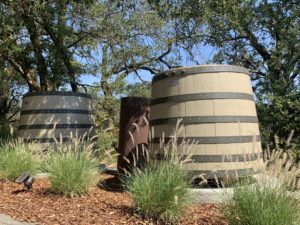
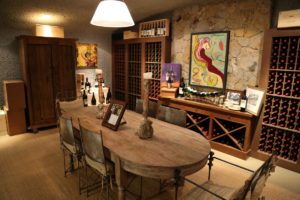
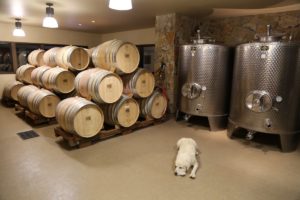 Sabina Vineyards is one of the nicest “garagist” wineries we have seen out of visiting and tasting with 1000+ Napa producers to date. This winery is the vision of David & his wife Susan Sabin (who both spent many years in Chicago) and was built based on the types of small Burgundian wineries they often visited during their travels to this region. In what is a very unusual setup for a physical Napa Valley winery space, the Sabins reside above the winery. The design implementation came from David DeSante. David is one of Napa Valley’s top winemakers; he created the winery designed around their tiny vineyard. He has significant winemaking experience at a variety of wineries (Robert Mondavi, S. Anderson – now Cliff Lede) and within several wine regions. Drawing upon a range of boutique wineries that he has visited and or worked for, he blended function and aesthetics seamlessly in a rather small location. David is no longer the winemaker; Alejandro Alfaro is the current Sabina Vineyards winemaker. Alejandro originally trained with David and has helped make every vintage of Sabina.
Sabina Vineyards is one of the nicest “garagist” wineries we have seen out of visiting and tasting with 1000+ Napa producers to date. This winery is the vision of David & his wife Susan Sabin (who both spent many years in Chicago) and was built based on the types of small Burgundian wineries they often visited during their travels to this region. In what is a very unusual setup for a physical Napa Valley winery space, the Sabins reside above the winery. The design implementation came from David DeSante. David is one of Napa Valley’s top winemakers; he created the winery designed around their tiny vineyard. He has significant winemaking experience at a variety of wineries (Robert Mondavi, S. Anderson – now Cliff Lede) and within several wine regions. Drawing upon a range of boutique wineries that he has visited and or worked for, he blended function and aesthetics seamlessly in a rather small location. David is no longer the winemaker; Alejandro Alfaro is the current Sabina Vineyards winemaker. Alejandro originally trained with David and has helped make every vintage of Sabina.
The name Sabina was chosen to honor David’s mother Sabina Sabin.
The property is 10 acres of which three acres are planted to vines, mostly to Cabernet Sauvignon with smaller amounts of Cabernet Franc. The winery was designed around these three acres, with extremely small steel fermentation tanks as well as small open top wood fermentation barrels. This is the site of an old Sauvignon Blanc vineyard which originally dated back to the late 1870s. And it was the property that Macauley Vineyard was founded on; one of the previous owners Ann Macauley hired winemaker Ric Forman and Jeff Sowells; they produced several vintages of a Sauternes-style dessert wine from Sauvignon Blanc grapes that were growing here at the time. Ann’s son Mac Watson continues to produce wines bottled under Macauley Vineyard with winemaker Kirk Venge at the helm.
When David and Susan purchased the property there was still evidence of some of the older vines. As a result of the existing vineyard footprint, they did not have to clear much forest land. The Sabin’s moved here in 2002 and planted vines a year later using cuttings from neighbors Dick and Ann Grace’s vineyard (known around the valley as the Grace clone). Their first commercial release from their estate vineyard was the 2006 Cabernet Sauvignon.
Their vineyard sits in an interesting location, it is in the “hourglass” of the Napa Valley – an area north of St. Helena where the valley narrows down into a small strip before opening up again into the northern part of the valley.
The vineyard is perched on the eastern facing slopes of the Mayacamas mountains just below Stony Hill’s vineyards. This is one of those unique and premium hillside vineyard neighborhoods that one finds in select parts of Napa Valley. Vineyard and winery neighbors include Colgin’s Tychson Hill, Vineyard 29 and Grace Family. Sabina’s own vineyards are farmed organically.
A number of mature olive trees dating back to the 1850s grow on the property, producing tiny olives typically every other year. In 2025, for the first time Sabina released a small batch production of olive oil from these trees. These trees were planted by Dr. Edward Turner Bale, the founder and namesake of the nearby Bale Grist Mill (a California state park). They used to shade an old dirt road which led from the Bale Grist Mill (used for hauling ground flour and other grains) to the north of the Sabina property down to St. Helena. This road was raised above the valley floor to avoid low spots in the valley that used to flood. One looks at these rows of old olive trees and imagines all the old horse-drawn wagons that must have passed by here in the mid to late 1800s -their ghosts still casting shadows which can’t be seen by the naked eye. An image of an etching of these olive trees is used as the label on their Cabernet Sauvignon. This etching was created by Santa Fe based artist Robert Kelly.
Because the winery is on site and the vineyard is so small, they can pick and choose when to harvest individual blocks or even rows. As a result, rather than picking all the vineyard at once, they pick only the areas that have reached physiological maturity. This is noteworthy, as the edges of their vineyard receive more shade from the nearby forest.
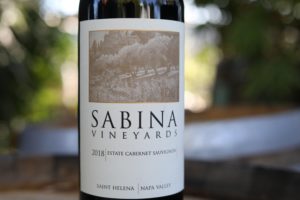
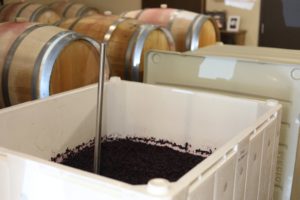
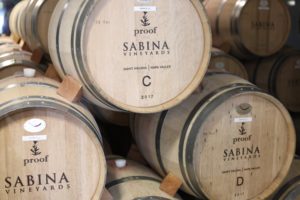 Refreshingly, this is a Napa producer who has gone against the grain of picking at extremely high brix levels – helped in part by their exposure and location. All of the wines we originally tasted were in the low to mid 13 percent alcohol range although in later years the alcohol has crept up slightly. David and Susan enjoy drinking lower alcohol wines. A key decision is made when harvesting; their fruit is picked at its ripeness but not at its over ripeness. All French oak is used ranging from normal sized barrels to larger puncheons. Fermentation is started with indigenous yeast.
Refreshingly, this is a Napa producer who has gone against the grain of picking at extremely high brix levels – helped in part by their exposure and location. All of the wines we originally tasted were in the low to mid 13 percent alcohol range although in later years the alcohol has crept up slightly. David and Susan enjoy drinking lower alcohol wines. A key decision is made when harvesting; their fruit is picked at its ripeness but not at its over ripeness. All French oak is used ranging from normal sized barrels to larger puncheons. Fermentation is started with indigenous yeast.
Sabina used to produce wines from non-estate fruit – from regions producing wines David enjoys drinking. Case in point is the Sabina Pinot Noir; Napa Valley based producers often source from Carneros and or AVA’s in neighboring Sonoma County but his Pinot Noir came from the Eola Hills in the heart of the Willamette Valley in Oregon (about an hour’s drive southwest of the city of Portland). This is not the first Napa Valley producer that has gone out of state to source Pinot Noir. Sabina experimented with several vineyards over a span of a couple of years and eventually decided on a single vineyard site. They made a Pinot Noir from the Willamette Valley for several years, but as of our latest update to this review they no longer produce Pinot Noir however may still have some of their older vintages for sale.
Select Wines
The 2012 Sabina Vineyards Willamette Valley Pinot Noir (tasted 10 years post vintage) is medium ruby in color; this wine has held up very well both on the bouquet and the palate. It offers elegant and layered aromatics including of raspberry, dried herbs, tobacco spice, hints of licorice and a light chocolate nuance. The palate is bright and still lively with flavors of red cherry, strawberry and currant. There is an underlying herbal note which adds to its complexity. Seamless, balanced and still beautiful. We are hoping that at some point Sabina Vineyards will revive their Pinot Noir production.
The label for this wine is an image of a painting by Chicago based artist Matt Lamb. Matt was a family friend (died in 2012) and was a prolific artist, creating more than 14,000 works during his life. His father’s business was as a funeral home director; after Matt took over the business, he grew operations significantly to numerous funeral homes before eventually selling the business to focus on his artwork. He was also known for his Umbrellas for Peace project, created in response to the 9/11 attacks. And some of Matt’s paintings are displayed in the winery.
The 2007 Sabina Vineyards Pinot Noir from the Roserock Vineyard is built with finesse; it is light to medium ruby in color and exhibits a beautiful softness and smoothness throughout. Earth tones show on both the bouquet (not too much spice) and the mid palate displays raspberry, strawberry and red currant. The finish lingers delicately. This wine is about balanced fruit; it is so silky and delicate from start to finish, a joy to drink.
The 2018 Sabina Vineyards Estate Cabernet Sauvignon is deep ruby in color; the bouquet immediately opens to a variety of secondary aromatics including of mocha, chocolate, old cedar box, sweaty leather and opens further to reveal dried herbs, spicy plum and some light pepper notes. The fruit will become more expressive given enough time, including notes of boysenberry and blackberry. This wine is medium bodied; the palate shows flavors of black raspberry and cherry. The grape and oak tannins are felt but without any harsh edges. Finishes with a noticeable length, a savory darker spice character, a woodsy note, dried tobacco leaf, medium acidity and rounded and lightly textured slightly drying tannins which continue to persist for quite some time.
For several years Sabina produced a 100% varietal Cabernet Sauvignon from Oakville. The 2006 Sabina Vineyards Cabernet Sauvignon despite the lower alcohol is a big wine showing rich ripe fruit. The nose is a wide mix of aromas showing black licorice, black cherry, crushed rock and cedar. The black fruit carries onto the palate where it picks up just a hint of mocha. Broad structured tannins anchor the wine. Good fruit, acidity, and lower alcohol make this a wine that should age very well.
The estate Reserve Cabernet Sauvignon is their most premium wine. The 2015 Sabina Vineyards Estate Reserve Cabernet Sauvignon was blended with the help of sommelier Kelli White, author of the massive tome, Napa Valley Then & Now. This bottling is 98.5% Cabernet Sauvignon, 1% Cabernet Franc and 0.5% Syrah from 80-year-old vines from a vineyard in Calistoga. This wine is medium to dark ruby in the glass; the bouquet offers aromas of dried tobacco spice, blackberry, black raspberry and dried herbs. It is somewhat savory. This is a complex very well-made wine without being heavy. Flavors include red cherry and red plum. The tannins are smooth but textured; this wine lingers savory with a bright acidity, a tobacco note and plenty of fruit. This wine was showing exceptionally well at the time of our tasting, 7 years post vintage.
The 2007 Sabina Vineyards Estate Cabernet Sauvignon is 13.1% alcohol, is well extracted and is inky dark in the glass; it was also slightly blended with estate Cabernet Franc. The nose is more elegant than their Oakville Cabernet Sauvignon yet shows an abundance of dark black fruit including black berry and black currant. It has a rounded rich entry and is a wine that tastes like their terroir. Notes of cedar, forest floor and black fruit run the length of the palate. The fruit is carried by broad shouldered tannins; there is good structure here and it is not out of balance. This is a wine also built to age but is drinking oh so beautifully while young.
—
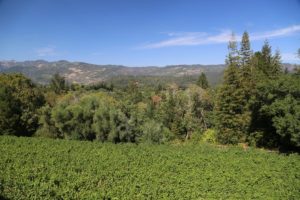
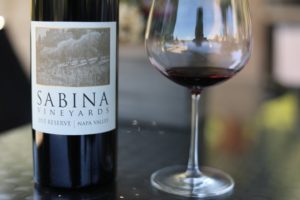
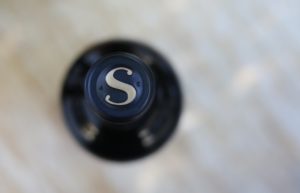 David has been involved in a number of business over his career including as Chairman of Salton Inc (a small electronics company) which became well-known through their partnership with boxer George Forman and the George Forman Grill. More recently he was owner and CEO of the the 100+ year old Fuller Brush Company (he moved the company headquarters to the city of Napa for a few years and also created another line of products during his ownership but has since sold the company).
David has been involved in a number of business over his career including as Chairman of Salton Inc (a small electronics company) which became well-known through their partnership with boxer George Forman and the George Forman Grill. More recently he was owner and CEO of the the 100+ year old Fuller Brush Company (he moved the company headquarters to the city of Napa for a few years and also created another line of products during his ownership but has since sold the company).
He also runs Elevation Wine Fund ( www.elevationwinefund.com), an investment group of collectors who buy and sell mostly cult wines, including both Napa Valley and French wines. For serious collectors looking for the big-name wines, (and big bottles) this is an excellent resource. They have an impressive selection of First Growths as well as the most well-known of the hard-to-find Napa cult brands. Their collection is well represented with wines from the 1990s through the present.
Visits to the winery are typically for collectors, serious wine enthusiasts and guests of select concierges and are typically hosted with a family member. A visit and tasting sometimes is curated around a private lunch. David and Susan are art collectors, and a variety of international pieces are displayed throughout their property. The best way to acquire the wine is directly through their website although they do have select distribution in Southern California. And they often have certain library vintages available for purchase or tasting.
For more information or to join their mailing list or wine club, visit: www.sabinavineyards.com






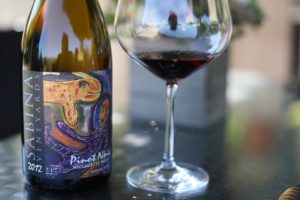
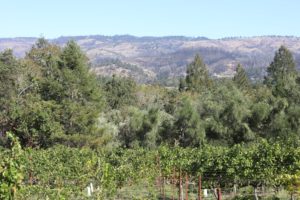
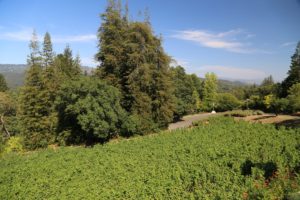
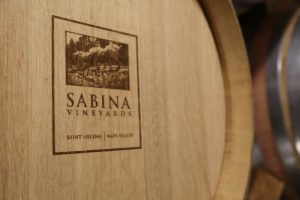
Hello Sabina!
Where can your wine be purchased?
Peggy – I hope you were able to connect with David directly. Cheers 🙂
Nice touch to see the recently added 20 year old fermentation tanks added next to the driveway 🙂